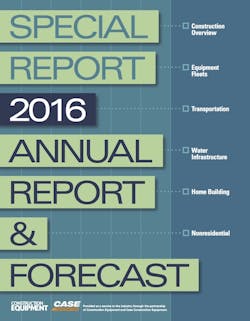Expectations for 2015 included pockets of confidence across the country and within the construction industry. The year turned out “good” in every region except the booming Southern Plains, which was “very good.” Last year also was “good” for each of the markets covered by the Scranton Gillette/SGC Horizon publications. Fleet managers, which work within all construction markets and have a more nuanced view of business conditions, said 2015 was a “very good” year. (Download the digital version of the full report.)
Forecasts for this year are even better as confidence appears to be solidifying.
Construction Sector Reports
Home building and nonresidential markets have a marked change in the way they view 2016 compared to 2015. Both expect this year to be a “very good” business year after 2015, which both rated as “good.” The water infrastructure market expects 2016 to mirror last year for business, forecasting another “good” year. Overall, expect 2016 to be a “very good” year for construction.
This positive outlook also transcends region. Whereas the Southern Plains was the only region reporting a “very good” year for 2015, all regions have similar expectations for 2016.
Revenue within the industry should be on the uptick, based on respondents’ expectations for contract volume. As an industry, 53.7 percent expect volume to increase and 11.4 expect it to decrease, resulting in a positive net of 42.3 percent across all vocations. Home builders, not surprising given the length of that industry’s downturn, have the strongest net at 55.5 percent (60.8 percent expecting contract volume increases minus 5.3 percent expecting decreases). Transportation reported a net of 21.4 percent (38.2 expected increases minus 16.8 expecting decreases).
Less difference exists across regionals. The net for the South Atlantic region tops out the country at 55.5 percent (63.9 percent expecting increases minus 8.4 expecting decreases). The Great Lakes region has the lowest net, 44.3 percent, representing 56.1 percent expecting increases minus 11.8 expecting decreases.
Previous Reports
Bid prices should also increase next year, with a net of 60.8 percent (64.6 percent of respondents expecting bid prices to increase minus only 3.8 percent expecting decreases). Nonresidential respondents are the most bullish, with 72 percent expecting bid price increases, and transportation the least, with 58 percent expecting increases.
Material prices will contribute to increases in bid pricing, with the industry reporting a net of 73.5 percent (75.5 percent expecting increases in material prices minus 2 percent expecting decreases). Among home building respondents, 83 percent expect material prices to increase in 2016; among transportation and water infrastructure respondents, 70.1 percent expect increases.
Even so, several industry reports cite labor cost as the true driver of increasing construction costs. “My No. 1 concern is the availability of labor,” said Ken Simonson, economist with Associated General Contractors of America.
Annual Report & Forecast Methodology
Scranton Gillette Communications and SGC Horizon publish several magazines in the construction sector. Participants in the 2016 Annual Report & Forecast asked their subscriber base about not only overall construction trends, but also trends specific to the construction sector in which they work. Each publication sent email invitations to its subscribers, inviting participation in an online survey.
More than 1,200 responded. Respondents by market include nonresidential, 332; fleet managers, 276; home builders, 209; transportation, 198; water infrastructure, 221.
Competition within industries and in construction as a whole continues strong, according to respondents. In 2015, 68 percent of respondents said their markets were “intensely” or “very” competitive. This response mirrors the 2014 results.
Market competition varies, with nonresidential reporting the most competitive construction market: 84 percent said their market was “intensely” or “very” competitive. Seven of 10 transportation respondents said their market was “intensely” or “very” competitive, and 63 percent of home builders said the same. The water infrastructure market was labeled “intensely” or “very” competitive by fewer than half of respondents: 46 percent.
Overall firm health continues strong, with 67 percent of respondents describing it as “very good” or “good” in 2015. Managers of firms in the water infrastructure sector were the most positive, with 75 percent reporting that overall firm health was either “very good” or “good.”
The Construction Equipment Annual Report & Forecast is presented in partnership with Case Construction Equipment.





